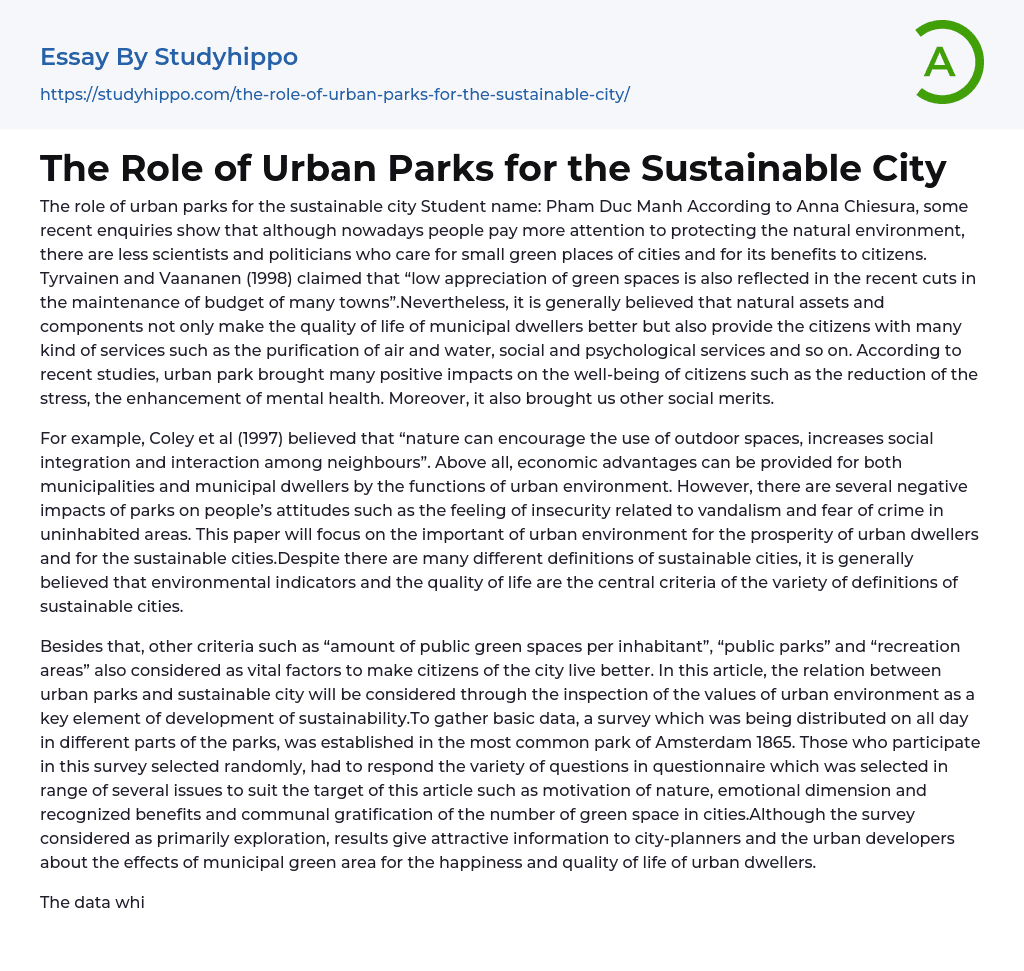

The Role of Urban Parks for the Sustainable City Essay Example
Pham Duc Manh explores the significance of urban parks in building sustainable cities. Although there is increased focus on environmental preservation, studies indicate a decrease in attention towards small green spaces within cities by scientists and politicians. According to Tyrvainen and Vaananen (1998), this lack of appreciation is evident in recent budget cuts for maintenance of green spaces. However, the positive impact of natural assets on municipal dwellers' quality of life is widely acknowledged. Urban parks offer numerous services to citizens, including air and water purification, social and psychological services, and more. Recent research has found that urban parks also positively impact mental health by reducing stress. Additionally, they provide other social benefits as well.
In 1997, Coley et al noted that natural environments can enhance social interaction among neighbors and encourage the utilization of outdoor spaces, leading to econ
...omic benefits for both municipalities and residents. Nevertheless, parks may provoke negative attitudes due to concerns about vandalism and crime in deserted areas. This study seeks to explore the importance of urban surroundings in fostering the welfare of city dwellers and constructing sustainable cities. Although there are different understandings of sustainable cities, environmental indicators and quality of life typically constitute crucial factors.
Focusing on the relationship between urban parks and sustainable cities, this article explores how the urban setting contributes to sustainable development. The argument posits that access to sufficient public green spaces per person, along with public parks and recreational areas, can improve residents' quality of life in a city. To investigate this issue further, a survey was conducted in Amsterdam's most popular park in 1865. Participants were randomly chosen to complete a questionnaire related to nature
appreciation, emotional responses, recognition of communal advantages, and satisfaction provided by green spaces within cities. Although an exploratory study, it offered valuable insights for city planners and developers regarding the impact of public green spaces on urban residents' happiness and wellbeing.
The collected data has been analyzed using both quantitative and qualitative techniques to provide an explanation. The results from the analysis of motivations for nature revealed that decision-makers could utilize this information to create strategies that align with the public's demands and expectations. Figure 2 illustrates that "To relax" was ranked highest in Motives for nature, with a frequency of 34. This could be attributed to the desire to escape daily routines and enjoy fresh air. "To be in nature" was the second most frequent response with a frequency of 254. Other motives, such as "To escape from the city," "To be with children," and "To meditate" followed in that order with frequencies of 154, 95, and 84, respectively.
Despite no gender differences, Table 1 in this article shows age disparities, with younger individuals preferring sports and social interaction while adults and older visitors prefer nature observation and relaxation with their children. The study aims to explore the emotional aspect of nature with regards to enhancing cognition and overall well-being. Participants were asked a range of 1-5 point and multiple-choice questions about their feelings towards nature, with Figure 3 demonstrating that freedom was the most commonly experienced emotion, with a frequency of 299.
The following categories were ranked in order of importance: Unity with nature (199), Happiness, Unity with myself, and Luck (163, 159, and 154 respectively). Like previous studies, there were no significant gender
differences but age correlations existed. Table 2 considered recreation and spirituality as two important factors. The results indicate that people’s emotional experiences play a vital role in their well-being. Additionally, participants were asked open-ended questions to express personal opinions regarding the importance of natural experiences for overall citizen prosperity.
Table 3 presents the key arguments and their interrelation. According to the evidence from Hartig et al's (1987, 1991) experimental study, natural environments offer effective remedies for stress and can help restore mental and physical well-being of urban residents. They remarked that "natural environments are a potent source of rejuvenating experiences". Similarly, Thompson (2002) observed that for a significant number of city inhabitants, parks embody a spiritual or metaphysical aspect of nature.
According to the survey, the current state of urban green space is dissatisfactory for 59% of the participants. To address this concern, it is suggested that sustainable criteria for urban development should include additional criteria regarding public places and green open spaces. The survey focused on understanding the motivations and perceptions of citizens towards a Dutch urban park, revealing varying age-related motivations and meeting citizen demands. While the precise role of urban parks was not clearly established, the study provides insight on related factors. Chiesura, A.
(2003) Landscape and urban planning 68 (2004, pp. 129-138) discusses the significance of urban parks in promoting sustainable cities.
- New York City essays
- Afghanistan essays
- Africa essays
- America essays
- Asia essays
- Australia essays
- Caribbean essays
- City essays
- Developing Country essays
- Dubai essays
- Earthquake essays
- Europe essays
- Fracking essays
- Georgia essays
- Middle East essays
- Natural Disaster essays
- New Zealand essays
- North Korea essays
- South Korea essays
- Thailand essays
- Travel essays
- Ambition essays
- Anger essays
- Betrayal essays
- Boredom essays
- Confidence essays
- Courage essays
- Desire essays
- Disgrace essays
- Doubt essays
- Empathy essays
- Fairness essays
- Fear essays
- Feeling essays
- Forgiveness essays
- Grief essays
- Guilt essays
- Happiness essays
- Harmony essays
- Hate essays
- Honesty essays
- Honor essays
- Hope essays
- Humanity essays
- Inspiration essays
- Kindness essays
- Laughter essays
- Loneliness essays
- Lost essays
- Loyalty essays



